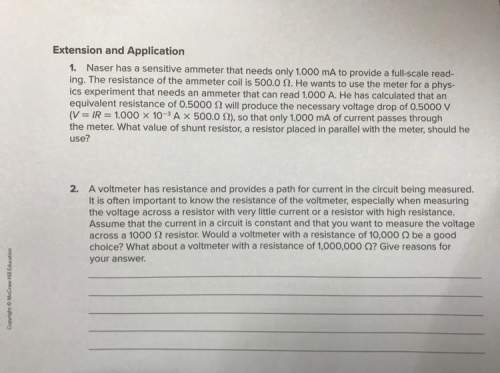
An electron traveling from the sun as part of the solar wind strikes the earth's magnetosphere at latitude 800Ⓡ Nin a region where the magnetic field has a strength of 15.0 AT and is directed toward the earth's center. The electron has a speed of 400 km/s and is directed toward the earth's axis parallel to the equator Magnetic forces send the election on a helical trajectory
Part A What is the radius of this helix?
Part B With what speed does the electron approach the surface of the earth?
Part C If you are looking downward toward the earth from space, is the electron's motion clockwise or counterclockwise?
a. The electron's motion is counterclockwise
b. The electron's motion is clockwise

Answers: 1
Another question on Physics

Physics, 21.06.2019 21:50
When applying kirchhoff's rules, one of the essential steps is to mark each resistor with plus and minus signs to label how the electric potential changes from one end of the resistor to the other. the circuit in the drawing contains four resistors, each marked with the associated plus and minus signs. however, one resistor is marked incorrectly. which one is it?
Answers: 1

Physics, 22.06.2019 07:50
Determine the fraction of the magnitude of kinetic energy lost by a neutron (m1 = 1.01 u) when it collides head-on and elastically with a target particle at rest which is 21h (heavy hydrogen, m = 2.01 u).
Answers: 3

Physics, 22.06.2019 08:00
Tafari worked one summer on a ship that set weather buoys in the ocean. he watched how one of the buoys moved in the water. describe which parts of the wave would cause the buoy to bob up and down. which wave property determined how fast the buoys bobbed in the water? he observed that when the wind blew harder, the ocean waves were larger, and the buoys moved away from the ship. what effect, if any, did the waves have on how far the buoys moved? explain your answer.
Answers: 3

Physics, 22.06.2019 13:20
It is reasonable to assume that the bulk modulus of blood is about the same as that of water (2.2 gpa). as one goes deeper and deeper in the ocean, the pressure increases by 10000 pa for every meter below the surface. if a diver goes down 80.0 m in the ocean, by how much does each cubic centimeter of her blood change in volume? give the answer in cubic centimeters (actually one cubic centimeter equals one milliliter).
Answers: 2
You know the right answer?
An electron traveling from the sun as part of the solar wind strikes the earth's magnetosphere at la...
Questions


English, 25.11.2021 09:10

Mathematics, 25.11.2021 09:10

Social Studies, 25.11.2021 09:10

English, 25.11.2021 09:10

Computers and Technology, 25.11.2021 09:10

Mathematics, 25.11.2021 09:10





French, 25.11.2021 09:20




Health, 25.11.2021 09:20







